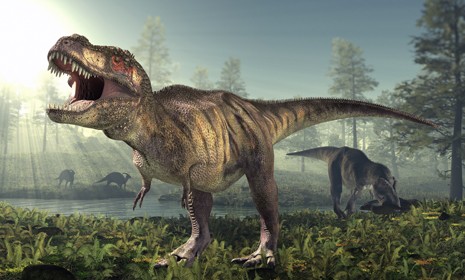Discovered: The even 'plumper' T. Rex
Was the fearsome Tyrannosaurus Rex more rotund and sluggish than previously imagined?

Was the king of dinosaurs even bigger than paleontologists thought? In short: yes. Scientists have used sophisticated 3D laser scanners and computer modeling to "weigh" five T. Rex specimens, including "Sue," the biggest and most complete tyrannosaurus rex skeleton in existence. What did they find? Not only were the lizards 30 percent bigger than originally estimated, they "grew at faster rates than anyone imagined—as much as 3,950 pounds per year," according to History. "That's a hell of a lot of cheeseburgers," says paleontologist John Hutchinson of Royal Veterinary College, who worked on the study. A guide to the fascinating findings:
Just how big were they?
Previously, the "tiny-limbed, razor-toothed" carnivore was estimated to be up to 40 feet long and weigh 14,000 pounds (seven tons) when fully grown, says History. Now? Thanks to the 3D modeling, the "plumper" beasts are estimated to have sported more than "18,000 pounds of muscle and flesh on their barrel-chested frames." So much for the svelte T. Rex we've seen chasing down jeeps in various Jurassic Parks.
The Week
Escape your echo chamber. Get the facts behind the news, plus analysis from multiple perspectives.

Sign up for The Week's Free Newsletters
From our morning news briefing to a weekly Good News Newsletter, get the best of The Week delivered directly to your inbox.
From our morning news briefing to a weekly Good News Newsletter, get the best of The Week delivered directly to your inbox.
What explains the jump in size?
Revised adolescent growth rates. Apparently, the dinosaurs had a monstrous appetite, especially as teenagers. "Intriguingly, the smallest and youngest specimen weighed less than thought," says Ben Hirschler of Reuters, "indicating that the T. Rex grew more than twice as fast [as previously assumed] between 10 and 15 years of age" — as much as 11 pounds per day.
So what if it's "plumper" than we thought?
Well, it means the "tyrant lizard king" might not have been much of a predator at all, says Nick Collins of Britain's Telegraph. "Until the end of the 20th century, it was assumed that the T. Rex was a fast runner, reaching speeds of up to 45 miles per hour as it chased down prey." Now? Not only is it "extremely unlikely" that it could even reach speeds of 25 mph, but it may not have been able to run at all. Citing paleontologist Jack Horner, Collins says "its sluggish speed, its 'useless' arms and its tooth structure all indicate T. Rex was a scavenger who'd would feast on carcasses killed by out-and-out hunters like Velociraptors."
A free daily email with the biggest news stories of the day – and the best features from TheWeek.com
Sources: History, Reuters, Smithsonian, Telegraph
-
 6 lovely barn homes
6 lovely barn homesFeature Featuring a New Jersey homestead on 63 acres and California property with a silo watchtower
-
 Film reviews: ‘Marty Supreme’ and ‘Is This Thing On?’
Film reviews: ‘Marty Supreme’ and ‘Is This Thing On?’Feature A born grifter chases his table tennis dreams and a dad turns to stand-up to fight off heartbreak
-
 Political cartoons for December 14
Political cartoons for December 14Cartoons Sunday's political cartoons include a new White House flag, Venezuela negotiations, and more